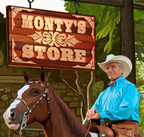I would like to see a lesson/s in proper barefoot trimming.
Rewards
Subscribe to Equus Online University and become a part of Monty's worldwide mission to leave the world a better place for horses and for people too.
Students automatically gain access to special rewards, such as exclusive discounts at the Monty Roberts Online Shop. Visit Monty Roberts Online Shop.




Hi!
Watch the viedeo series "Join-Up with the Farrier", there ist a very good lesson about that topic with Ada Gates.
Best wishes from Hamburg, Germany
Jasmin
Yes. Good suggestion! I have seen that too but i haven' t met a ferrier who brings all this Instruments with and messures out as Ada does. The question ist, how can i get the ferrier to change his methodes and what can i do, when after his visit everything is wrong?
There is a farrier on here (Paul) who may be able to advise you, but I strongly recommend that if the farrier you are using is not right for you then you change him! When you look to appoint a new farrier explain your beliefs and values and see if they match - I appreciate its not easy to find the 'right' one and sometimes we have to compromise a bit - mine is not perfect but I make sure things are done my way while accepting his expertise and knowledge (he does a beautiful barefoot trim!). I do have a great deal of sympathy for farriers who are expected to work on difficult/untrained horses and they get short tempered sometimes (as mine can do, but he has been severly injured a few times and is quite rightly fed up with it!). I make sure mine stands very quietly with no fuss. As Monty says, its up to us to train the horse for the farrier. It's hard to stand up to professionals Torero, but if he is doing something wrong he needs to be told. Good luck.
Hello Vicci, nice of you to think of me. Hope your xmas was pleasant and may your New Year be a happy one.
Well Luktha(?), as you probably now know, simply from comments from individual horse owners on this site, that there are good farriers and bad farriers, as is the case in all of life's professions. Unfortunately when one "googles" when looking for a guide of sorts for the uninitiated, there seems to be as many differences of opinions as there are farriers. I did just that, and to my utter amazement and disappointment noticed that "not one", not one farrier, when demonstrating doing a barefoot trim on a horse, be it (the horse) new to him/her or otherwise, asked to see the horse "travel" first before doing anything. As well, none of them, used a hoof gauge or measured the hoof wall length. Some, to their credit did measure and identify the coffin bone end point for a roll over "marker", for putting a shoe on in particular.
However, you are interested in "barefoot". Well, the basic "rules and tools" are simple and are taught to all farriers regardless of the school they attended. First of all you want to see your farrier make up a "card" for your horse, with your horse's name written on it. Sound too simple?...trust me, I've seen horses be mixed up because of failure to do so. Then, do the following, making certain to write down all of the observations and measurements on the card. They should ask to see the horse travel, towards them, away from them, as well as from both sides, for obvious reasons. Then measure the hoof wall lengths and angles. The rule of thumb is that the front feet have an angle of roughly between 50 and 55 degrees and the hind, roughly between 55 and 60 degrees. Now, keep in mind, that these angles are to be commensurate with the "pastern angle" of the specific horse, as they all vary according to the animal. Ideally both front angles and wall lengths should be as close to as perfect match as possible, as well as the hind, should be as perfect a match as possible. Some farriers will disagree, and they are wrong, just ask them what they were taught at farrier school and what "equine bio mechanics and equine kinesiology" shows them to be incontrovertibly the case. Sometimes familiarity breeds contempt, and apathy sets in soon after.
Just try walking around with a heel missing from one of your shoes, or with just the tiniest of grains of sand in your shoe...see how that feels. Most horses, (not all) but most horses will not convey this discomfort until lameness occurs or they just get so discomfited that they become irritable and won't listen or become hard to handle and less responsive...very seldom will the farrier get blamed, and yet, (in some cases) that is precisely the problem.
It NEVER ceases to amaze me, the amount of BS most horses will take and never complain. If they could talk, I'm sure the air would be blue most of the time....poor things.
Anyway, sorry, I got carried away there. Another point, almost always, for an "ungauged" hoof, angle changes are needed and should never exceed 3 degrees as it stresses ligaments quite profoundly and not immediately but over a period of several days, depending on use, will sometimes lame them up. As well, barefoot horses should have a gentle roll all around the circumference of the end of the hoof wall. Sometimes this is referred to as a "mustang roll"...some farriers get badly carried away and almost literally square the toe off....bad idea obviously, simply look at videos and still pics of feral horses to see. Its nothing more that a gently rounded curve that is little more rounded at the "roll over point" of the hoof wall.
So, in conclusion, your farrier (just as he/she was taught) should have a hoof gauge for angle and USE IT...lol. The gauge also measures the hoof wall length. Have a ruler or "equine hoof leveller" for measuring the "bottom" of the hoof to ascertain and achieve balance.
For barefoot, more sole and a little more frog is left on than generally is of course for added protection.
So, thats it for me...now you have a problem, (or maybe you don't?). Telling your farrier what you want, or correcting your current farrier....I do know from experience that there is a scarcity of good farriers around the world. All of us are taught correctly (I think anyway) and yet as time progresses, unfortunately, shortcuts abound, instruments are not used, time is money, yadayadayada.
After all, would you hire a carpenter to build your house if he did not use any instruments whatsoever?....I think not, well,just think, our horses are living, keenly sensitive and kind creatures that someone is "cutting away on. You get, "Don't confuse me with the facts, my mind is already made up",..."I can set this horse up with my eyes shut"...I've heard it all. I have actually seen some horses shod that I thought that perhaps Stevie Wonder had done...lmao.
Anyway, you have to develop the gift of gab for some situation that would provide as follows:...that being the ability to be able to "tell someone to go to hell, in such a way, that they will actually look forward to taking the trip". Once you have achieved that, you can go ahead with absolute confidence and convey quite nimbly to your farrier what you wish,lol.
In order to help you with that, I do not suggest that you tell your farrier that you got your information from another farrier. That would possibly be insulting.
So, to that end, I have provided you herewith a "hotlink" to a site that you may advise your farrier that you stumbled across and simply refer him to it. It has some very beneficial information for all and sundry, initiated or not, and commentary by Dr. Goble.
Dr.Dallas Goble is a member of the International Equine Veterinarians Hall Of Fame and a former director of Equine Clinics at the University of Tennessee, and head veterinarian for the Budweiser Clydesdales, National Herd Health Program.
Here is your link, and I bid you good luck and a very Happy and Prosperous Horsey New Year... : )
http://www.americanfarriers.com/pages/Features-Hoof-Care-And-The-Coffin-Bone.php
Paul here again. I forgot to make a very simple recommendation. "No foot, no horse"...we all know this intelligent admonition and yet virtually 95 percent of horse owners that I have met do not know what to look for in a good trim job or a in a good shoeing job.
So, all horse owners should spend an average of twenty dollars and buy a "hoof gauge" and spec out their own horses wall angles and lengths and do a comparison of each of the feet and make note of the differences. Some of you will be very shocked and very upset (as you should be) at what you will notice.
Regards,
Paul
Thank you very much Paul, I'm sure all of us can learn so much from this posting and the link you added!
Happy New Year!!
Miriam
Thank you Paul. One more thing to study! Even after 20+ years in the horse world it's amazing how much we knew, forgot and need to re learn. I'm grateful there are good people to learn from. Cheers
Paula